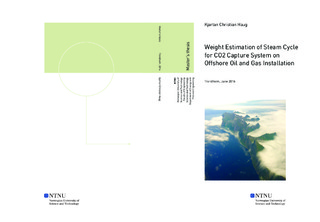| dc.description.abstract | Climate change due to increasing anthropogenic CO2 emissions is a major concern both in Norway, and globally. Greater environmental focus and increased taxes on emitted CO2 have led to corporate efforts on reducing CO2 emissions. Offshore gas turbines are one of the largest sources of CO2 emissions from the Norwegian industry. One option to reduce the emissions is to capture CO2 from the gas turbine exhaust gas, followed by compression and offshore storage. This process is known as carbon capture and storage (CCS). Due to strict sizing limitations on offshore oil and gas installations, implementation of CCS is totally dependent on a compact and low weight design. To run this process, the reboiler in the desorber section of the CO2 capture plant requires steam. This steam is produced in a low weight steam bottoming cycle that is designed as a part of this study. The aim of this study is to answer the research question: What is the preferred weight estimating method for steam bottoming cycles on offshore oil and gas installations, polynomial representation or scaling laws?
To arrive at a reliable weigh estimate, the steam cycle design is further developed from the specialization project, completed in December 2015. In the simulation software GT PRO, the steam cycle is integrated with CO2 capture and desalination. Because of its importance, the major focus in the design phase was on weight reduction. The total weight is calculated for the fundamental steam cycle components; steam turbine, generator and heat recovery steam generator, and is found to be 437.8 tons. The proposed design produces 37.7 kg/s of saturated steam at 5 bar and has a net positive power output of 5 MW with both CCS and desalination implemented, and is therefore self-sufficient with both steam and power.
Some promising results for weight estimation have been found. Two different methods were implemented; polynomial representation from weighted least squares method and scaling laws from robust fitting. The polynomial offers more flexibility, because more than one variable can be considered. If one desires a more detailed analysis, or if several design parameters are not yet determined, the polynomial approach is suited. The considered variables are steam and exhaust mass flow, and exhaust temperature. If the boundary conditions are fixed, as in this study, the scaling laws are spot on. Scaling laws form a very elegant linear solution when steam mass flow is considered in the weight estimation. The analyzed real weight data support a linear scaling relationship between weight and mass flow. The base case polynomial estimate made an error of 1.4%, while the scaling law estimate deviated by 0.5%. During validation tests, also outside the calculated range, the maximum errors were 2.2%and 3.1% respectively. The linear scaling law results were almost unrealistically consistent within its calculated range (<1%). This is most likely related to software limitations in GT PRO. | |

